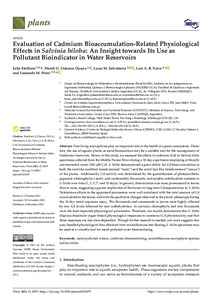Por favor, use este identificador para citar o enlazar este ítem:
https://repositorio.uca.edu.ar/handle/123456789/14027| Título: | Evaluation of cadmium bioaccumulation-related physiological effects in salvinia biloba: an insight towards its use as pollutant bioindicator in water reservoirs | Autor: | Emiliani, Julia Llatance Oyarce, Wendi G. Salvatierra, Lucas Matías Novo, Luís A. B. Pérez, Leonardo Martín |
Palabras clave: | SALVINIA BILOBA; CONTAMINACION DEL AGUA; METALES; BIOMONITOREO; ESPECIES DE MACROFITAS AUTOCTONAS | Fecha de publicación: | 2021 | Editorial: | Multidisciplinary Digital Publishing Institute | Cita: | Emiliani, J. et al. Evaluation of cadmium bioaccumulation-related physiological effects in salvinia biloba: an insight towards its use as pollutant bioindicator in water reservoirs [en línea]. Plants. 2021, 10 (12). doi: https://doi.org/10.3390/plants10122679. Disponible en: https://repositorio.uca.edu.ar/handle/123456789/14027 | Proyecto: | Estudio de los bioprocesos involucrados en la eliminación de contaminantes químicos en diferentes sistemas biológicos | Resumen: | Abstract: Free-living macrophytes play an important role in the health of aquatic ecosystems. Therefore, the use of aquatic plants as metal biomonitors may be a suitable tool for the management of freshwater reservoirs. Hence, in this study, we assessed the effects of cadmium (Cd) in Salvinia biloba specimens collected from the Middle Paraná River during a 10-day experiment employing artificially contaminated water (100 µM Cd). S. biloba demonstrated a great ability for Cd bioaccumulation in both the root-like modified fronds (named “roots”) and the aerial leaf-like fronds (named “leaves”) of the plants. Additionally, Cd toxicity was determined by the quantification of photosynthetic pigments (chlorophylls a and b, and carotenoids), flavonoids, and soluble carbohydrate contents in S. biloba over time (1, 3, 5, 7, and 10 days). In general, deterioration was more pronounced in leaves than in roots, suggesting a greater implication of the former in long-term Cd sequestration in S. biloba. Deleterious effects in the appraised parameters were well correlated with the total amount of Cd accumulated in the leaves, and with the qualitative changes observed in the plants’ phenotype during the 10-day metal exposure assay. The flavonoids and carotenoids in leaves were highly affected by low Cd levels followed by root carbohydrates. In contrast, chlorophylls and root flavonoids were the least impacted physiological parameters. Therefore, our results demonstrate that S. biloba displays dissimilar organ-linked physiological responses to counteract Cd phytotoxicity and that these responses are also time-dependent. Though further research is needed, our work suggests that easy-handled physiological data obtained from autochthonous free-floating S. biloba specimens may be used as a valuable tool for metal-polluted water biomonitoring. | URI: | https://repositorio.uca.edu.ar/handle/123456789/14027 | ISSN: | 2223-7747 (online) | Disciplina: | INGENIERIA AMBIENTAL | DOI: | 10.3390/plants10122679 | Derechos: | Acceso abierto | Fuente: | Plants Vol.10, No.12, 2021 |
| Aparece en las colecciones: | Artículos |
Ficheros en este ítem:
| Fichero | Descripción | Tamaño | Formato | |
|---|---|---|---|---|
| evaluation-cadmium-bioaccumulation.pdf | 39,79 MB | Adobe PDF |  Visualizar/Abrir |
Visualizaciones de página(s)
60
comprobado en 27-abr-2024
Descarga(s)
42
comprobado en 27-abr-2024
Google ScholarTM
Ver en Google Scholar
Altmetric
Altmetric
Este ítem está sujeto a una Licencia Creative Commons

